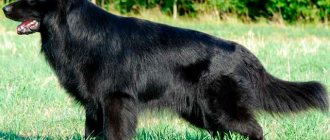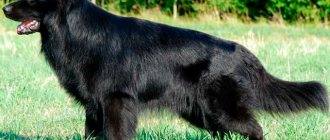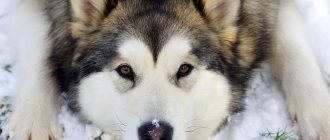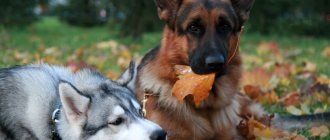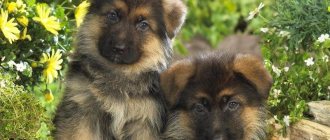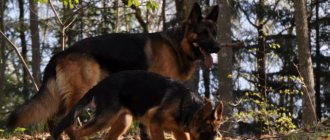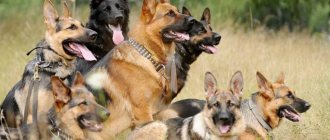Interesting facts about the dog breed
- German Shepherds are distinguished by the fact that they are capable of performing a wide range of functions, so they can be found both in the service and as a family friend.
- This breed is characterized as flexible, intelligent and loyal, while understanding that the person is in charge.
- The German Shepherd breed is one of the three most intelligent dog breeds, which also includes border collies and poodles.
- They simply need physical activity, as well as communication with people.
- They perfectly find a “common language” with children of all ages.
- They can live indoors or in enclosures without problems.
- A shepherd dog can live for at least 9 years, but after 7 years of life, it is necessary to carry out comprehensive monitoring of the dog’s health.
The German Shepherd has always been at the top of rankings that include the smartest, most loyal and most trainable dog breeds. The faces of these animals can be seen in news shows, on newspaper pages and on the pages of magazines and books. Quite often, German Shepherds take part in various television shows. And yet, despite such a high authority of this breed, its main task is to maintain law and order. Therefore, German Shepherds are found in police departments, border and customs services, and also rescue people. At home, these dogs become full members of the family, protecting the peace and property of citizens, as well as the citizens themselves and their family members from outside attacks. At the same time, they help all family members cope with negative emotions, recharging themselves with positive ones.
Flaws
The breed disadvantages of the German Shepherd include the following:
- the absence of a third premolar and one more tooth;
- the absence of one canine;
- absence of the fourth premolar;
- absence of the first or second molar;
- the absence of three or more teeth;
- a bite of two millimeters or more;
- underbite;
- pincer bite;
- deviation of one centimeter in height prescribed by established standards;
- albinism;
- white hair color with dark claws and eyes;
- long guard hair, soft and loosely fitting, forming dewlaps in the ear area and feathering on the limbs with thick trousers and a tail with dewlap below;
- long coat without undercoat with partings along the back.
Serious faults include any deviations from existing standards that negatively affect the basic working qualities of an adult dog. The main ear defects of the German Shepherd are represented by ears located on the sides or too low, semi-dropping ears hung on the sides, as well as erect ears without elasticity. Significant defects also include impaired pigmentation, a noticeable decrease in the animal’s overall endurance, and disturbances in the dental apparatus, including any deviations from a scissor bite.
Return to content
Historical data
In order to trace the pedigree of various types of breeds, even if they became known already in the 19th century, and even more so in the 20th century, it is enough to rummage through special documents or use eyewitness information. As for the German Shepherd breed, not everything is so simple, since experts say that the ancestors of this breed should be sought much deeper.
Archaeological data obtained as a result of excavations in the territories of some European countries indicate that back in the 4th millennium BC there were dogs whose skeletons were very similar to the skeletons of modern shepherd dogs. According to experts, their ancestors are wild individuals who lived near the sites of ancient people, as a result of which they began to obey the will of man.
Scientists also suggest that already in those days primitive breeding work was carried out, as a result of which preference was given to strong and obedient individuals.
The small Indian wolf, which no longer exists in our time, increasingly moved away from its independent relatives, eventually acquiring the status of Bronze Age dogs. As time passed, humanity gradually developed, as a result of which the needs of all humanity changed. Despite this fact, farmers and pastoralists have always been tied to a specific area. As a result, four-legged companions began to master new functions. Throughout Europe, and especially in the Middle Ages, it was customary to breed Hofwarts. Translated from German, this means “guardian of the yard,” although dogs also performed other functions not related to real estate protection.
In those days, the area was simply teeming with predators, and domesticated livestock needed protection. In addition, already in those days there were many who wanted to profit from other people’s goods. Man could not cope with his responsibilities on his own, especially when he had to graze numerous herds. Therefore, man had to take advantage of the capabilities of yard dogs. Not all dog breeds could cope with the protection of numerous flocks, but only those that were distinguished by endurance and intelligence. The problem was also to select and train the animal. Such dogs were so valuable that in those days, for killing a dog that was herding flocks of livestock, the culprit faced death punishment.
According to experts, animals of the Medieval period, including those of later eras, were significantly different from modern representatives of various breeds. In those days, the main attention was paid not to the shape of the body, but to the mental abilities of the animal and its endurance. No less important was the “psychological portrait” of the dog, which was always next to the person. As a rule, the shepherds were isolated for a long time, throughout the entire season of keeping the animals, so the dogs were in contact exclusively with the shepherds all this time. And here the most important thing is that the dogs unquestioningly perform their functions. Moreover, the dogs were supposed to become real friends and companions for the shepherds.
By the end of the 17th century, the main characteristics of herding dog breeds began to appear. Two regional breeds have become widespread: the semi-long-haired Thuringian dogs with a curled tail and a fawn-gray color, as well as the long-haired Württemberg dogs with semi-erect ears, distinguished by a black or red color. These 2 breeds also differed in their behavior. If the former were considered very active animals and often barked loudly, then the latter were calmer and more resilient. Therefore, the breeders decided to join forces to develop a completely new breed of dog.
A lot of time passed and at the end of the 19th century the result of long and painstaking work was presented to the general public. In 1882, Baron von Knigge presented two of his pets at the Hanover Exhibition. Interest in the new breed arose with renewed vigor when the owners of the Hannau kennel showed off their impressive pair. Thanks to this couple, at least 2 dozen champions and winners of subsequent dog shows were born.
In 1891, it became known about the creation of the first club of German Shepherd lovers, although this organization, called “Philax,” did not exist for so long, and it was able to determine the breed standards in such a short period. On the German-French border, in the city of Karlsruhe, an exhibition took place, which is considered to be significant. The event was not anything extraordinary, but at the exhibition many saw a unique representative of the old-format breed. However, he did not take part in the exhibition.
Hector von Lyrkenheit did not do anything supernatural, but only entertained the audience, demonstrating the shepherding skills of his pet. At that very moment, two friends happened to be nearby, who in their free time practiced breeding German Shepherds. They immediately noted that the dog’s external characteristics were not inferior to his shepherding skills. The owner refused for a long time to provide his dog for breeding work.
Since friends believed that they had got the ideal representative of this breed, they included him in the list of breeding work at number one. From that moment on, they began to look for a bitch for the dog who would have similar characteristics to him. It took very little time, and the couple produced offspring worthy of imitation of this breed. As a rule, even modern successors of this family have a purebred line associated with this “ideal German”.
Claude von Boxberg is considered another famous representative of this breed, since he took part in the 1925 international exhibition and won a landslide victory. This moment is considered the factor that marked the beginning of a new breeding line.
In 1936, when Max von Stephanitz died, members of the National Socialist Party insisted that the breed should not appear outside Germany. It is believed that the events of this period were the cause of his death, as national patriots threatened this man, intending to send him to a concentration camp. During the Second World War, many animals were destroyed, including nurseries for their breeding. Nobody cared about the purebredness of the surviving individuals. In fact, it was possible to preserve several purebred individuals, and in the post-war years there were enthusiasts who set to work to restore this unique breed. Already in 1946, exhibitions continued, and after another 5 years a new winner appeared, who became the founder of the modern lines of purebred German Shepherd.
The German Shepherd Owners' Union was created back in April 1899. The activities of the leaders of this Union were aimed at maintaining the purity of blood, confirming this with relevant documents. At the same time, it was practiced to encourage breeders who developed the working characteristics of the breed. This organization has survived to this day. In May 1968, an international association began its work, which is known today as , which has brought under its “wing” 89 national unions from 82 countries of the world.
GERMAN SHEPHERD – INTERESTING FACTS
Appearance of a German Shepherd
Dogs of this breed are medium in size. Males have a height at the withers of about 65 cm maximum, with a maximum weight of 40 kg. Bitches are slightly smaller in size: they are 5 cm lower and 8 kg lighter. It should be noted the optimal ratio of the animal’s weight to its height. The dog is distinguished by a slightly elongated body shape, strong build, strength and power, while the skeleton is not coarse.
Head
The proportions of the head are such that its length is about 40%, in relation to the height of the dog at the withers. The shape of the head is wedge-shaped. The forehead has a slight convexity. The size of the cranial part is the same as the facial part. The transition between these parts of the head is smooth and barely noticeable.
Neck
It is believed that the length of a German Shepherd's neck corresponds to the length of its head. The neck is strong, muscular and quite mobile.
Eyes
The eyes are medium in size, oval in shape and dark in color. Not convex and slightly obliquely spaced.
Nose
The nose is black in color, while the nose has the usual shape for a dog, without a dividing strip.
Teeth and jaws
The German Shepherd has well-developed lower and upper jaws. Each jaw has a full set of strong teeth. The bite is normal, and the lips fit tightly to the jaws.
Ears
The German Shepherd breed has large, erect, triangular-shaped ears that run parallel. The ears point forward. The ear cartilage is elastic, without visible flaws.
Torso
The German Shepherd has a long chest that is deep and wide. The ridge line runs obliquely from the withers to the croup, while the withers are powerful, the back is wide and strong, the croup has an inclined shape and a barely noticeable transition to the base of the tail.
Tail
This breed has a fairly long, slightly curved tail that usually points downward. The tail is fluffy, and the hair on the lower part of the tail is somewhat longer.
Limbs
The forelimbs are without bends, and if you look from the front, they are set parallel, while they are muscular and strong. The humerus and shoulder blades are the same length and are connected at right angles.
The hind legs, when viewed from behind, are also straight and parallel, but at the same time slightly set back. The thigh and lower leg are connected at an angle of 120 degrees, but at the same time have the same length. The hind legs are also muscular and strong. The paws on the forelimbs are quite compact, with toes that have a slight arch.
Wool
The German Shepherd boasts a double coat, with thick, straight and coarse bristles and a thick undercoat.
Color
The main color is black, with reddish-brown, brown or yellow markings, to light gray. Solid black or solid gray color is also possible.
Color
According to breed standards, the German Shepherd can be black in color with reddish-brown, brownish, yellow or light gray markings. The color can be monochromatic black and gray, but with a gray color with a darker coating. The undercoat is characterized by a light grayish tone, but white color is unacceptable. The color may have a black cloak and mask. The presence of inconspicuous small white markings in the chest area, as well as too light inner sides, is quite acceptable, but not desirable.
The nose of animals of any color should be exclusively black. Weakness of pigment may be represented by the absence of a mask, piercingly light eyes, and light to white markings on the chest or inner sides. Also, the weakness of the pigment is indicated by light claws and the presence of a red tip on the tail.
Return to content
Personality of the German Shepherd
As a rule, owners of this breed indicate that the dog is loyal, intelligent, calm and obedient. The excellent character of an animal is associated with a stable psyche, strengthened by proper upbringing.
The intellectual abilities of German Shepherds are not aimed at their desire to be independent and stubborn, but on the contrary, they easily master new teams, games or territories. These dogs do not like loneliness, but can wait for their owner for a long time. Their good health and normal mood are inextricably linked with communication with a person, in conditions of long walks or outdoor games.
The most important characteristics of the German Shepherd are its innate instincts to protect various objects, therefore it is always wary of strangers, but without certain conditions it does not show aggression. This dog is so devoted to its owner that it is ready to protect both the owner and his family members until his last breath. Moreover, the dog is able to react to danger instantly.
German Shepherds understand where children are and where adults are, so they play with children with great pleasure. However, children should not be left alone with the dog, as there is a big difference in size and weight. The Shepherd is also tolerant of other pets, especially if they grew up together.
GERMAN SHEPHERD. Pros and cons of the breed
The process of education and training
German Shepherds are quite intelligent animals that are easy to train. But under no circumstances should this process be allowed to take its course. From the first months of its existence, the puppy is provided with all forms of various games and tasks. As a result of completing tasks and commands, the puppy must be rewarded with treats. As a result, the puppy develops certain concepts about the norms of acceptable behavior and the implementation of basic commands.
A person must demonstrate his mental abilities and love for an animal without raising his voice and, especially, without using physical force. Not everyone is able to cope with this difficult task on their own. Therefore, in the case when a person is not able to cope with this task, one should seek help from specialist dog handlers.
Naturally, not every individual is capable of performing security functions. Despite such facts, any shepherd dog must understand and follow basic commands, such as, “Come to me!”, “Place!”, “No!”, “Near!”, “Sit!”, “Lie down!”, “ Walk!”, “Fetch!”.
When the puppy gets stronger, you can begin physical activity, training the animal to overcome obstacles. It is especially important to train your dog to walk on a leash, and then, after reaching six months, in a muzzle. At the same time, we should not forget that the animal must be rewarded for obedience.
You should also remember that you need to do it in the first 3 years. During this period, the still young dog, which meets all the indicators of the breed standard, remains psychologically vulnerable, requiring care and love, as a puppy.
Care and maintenance
The structure of the German Shepherd's coat is such that it can live both in a person's home and in the yard. If kept in the yard, it is necessary to build a spacious enclosure with a warm booth. It is advisable that the enclosure be protected from wind and precipitation.
If it is assumed that the shepherd will live in the house, then it is necessary to allocate its own place where bedding and a mattress, as well as various toys, should be placed. There should be no sources of heat or drafts near the animal’s place. When decorating a place, it is better to use natural materials that do not require complicated cleaning. The presence of various toys will allow you to save furniture and shoes from the encroachments of your toothy friend.
It is very important to provide your pet with proper, balanced nutrition, which will help protect the animal from abnormal development and the manifestation of illnesses. A complete diet is only possible if high-class (premium or super-premium) factory dry food is used. In this case, it is necessary to take into account the age categories of the animal. When eating natural foods, it is necessary to ensure a balance of fiber and protein intake. Under no circumstances should you give your shepherd dog leftover food from the human table, since the dog’s digestive system is not designed to consume fatty, fried, salty and other foods with seasonings. Fresh water should be freely available.
This breed does not require frequent washing of the dog with various shampoos, but as it gets dirty, it is necessary to do this. In this case, it is necessary to comb the coat a couple of times a week. When the animal sheds, this procedure will have to be carried out much more often. It is equally important to monitor the condition of the ears, eyes, teeth, and nose.
Experts recommend visiting a veterinarian at least 2 times a year.
German Shepherd - Care and Maintenance // Network of Veterinary Clinics Bio-Vet
general description
Refined appearance, discipline, energy, neatness are exemplary traits of the breed. A breeding dog with an excellent sense of smell and absolute hearing, a stable central nervous system. Athletic and large build, slightly stretched, above average size.
The ratio of height and length is 9:10, respectively, height is less than length by about 10%.
Average height recorded by the standard:
- For males – 63 cm;
- For females – 56 cm.
A deviation of 2 centimeters is possible. Changes in different directions from the average height significantly reduce the pet's advantages.
The constitution of the body guarantees the feasibility of long running, and the coat protects from natural weather influences.
Sexual characteristics of cables and bitches are extremely pronounced. Clearly expressed, developed two testes near the cables are located in the scrotum.
Now let's look at the exterior of the German Shepherd, those predominant characteristics, the preservation of which is necessary when breeding pedigree breeds.
Read more in the article “Weight and height of the German Shepherd by month.”
German Shepherd Health and Diseases
A German Shepherd can live on average for about 13 years maximum. As a rule, all work related to the breeding of a particular breed of dog entails many negative factors that seriously affect the health of the animal. A number of diseases begin to appear as early as the puppy's age. This is a problem with hormone deficiency, this is diabetes, and leukemia, this is intermittent claudication (eosinophilic panostitis), as well as intussusception and pyoderma.
As the dog grows and develops, it may develop allergies, hip dysplasia, intervertebral disc problems, arthritis, eye problems, epilepsy, pancreatic problems, heart problems, hind limb paralysis, cancer, etc.
As a result of exposure to external negative factors, the dog may develop eye and ear infections, dermatitis, volvulus, bloating, etc.
When it is noticed that your pet has some health problems, you should immediately seek help from a veterinarian. Only a specialist can make the correct diagnosis and prescribe qualified treatment. It is very important not to wait until the dog has some problems with its organs, but to constantly visit a specialist for routine examinations. This is especially true for puppies, as well as individuals over 7 years of age.
Gait, movements
German Shepherds are natural trotters with coordinated limbs and angulations, allowing the hind limbs to move the length of the body and the front limbs to extend without significant changes to the topline. The presence of any tendency to reduce the angles on the hind legs contributes to a decrease in the strength and endurance of the animal.
The correct proportions of the body and angles determine the appearance of sweeping movements running parallel to the surface, giving the impression of easy movement in the forward direction. With the head bent forward and the tail slightly raised, a gently swaying and continuous dorsal line is formed during a calm and uniform trot.
Return to content
How to choose the right puppy
All the characteristics of the animal described above are inherent in individuals whose pedigree is officially confirmed by documents. Individuals that are not of pure blood (half-breeds) may also have a similar external and psychological portrait, but this category of German Shepherds represents completely different dogs.
Prospective owners who are interested in getting a specific breed of dog should look for puppies from trusted individuals and kennels that have an excellent reputation. Only in such conditions can you purchase a puppy that has no breed defects. It is very important that the future pet has a stable psyche, which is typical for purebred individuals.
As a general rule, responsible breeders will not sell puppies under a minimum of 8 weeks of age. By the 2nd month of life, puppies are already confidently standing on their paws, responding to their name and are ready for the training process.
If the future pet is planned to be used to participate in exhibition shows, then the main selection criteria come down to its health and friendliness. The fact that the puppy is absolutely healthy can be evidenced by its playful behavior, clean eyes, nose, and ears. In addition, the puppy should have an excellent appetite, an elastic belly without signs of bloating, and shiny coat. A German Shepherd puppy should behave calmly around people and not show aggression if someone wants to approach him.
It would be nice if the future owner of the puppy “gets acquainted” with its parents. In this case, a complete picture of the hereditary traits of the future pet can be formed. It won’t hurt to see the conditions in which the puppy and its parents are kept. If their space is clean, has quality food, and has a sufficient supply of toys, all of these factors indicate that the breeders are serious people. Plus, the future pet must have all the necessary vaccinations.
How much does a German Shepherd cost?
Puppies that have a "champion" pedigree and are potential winners of future shows are sold for at least $1,000. They can be purchased at the age of 5 months, when their external characteristics have already been formed, and they also have some experience in participating in junior “shows”.
If the puppies, although they are purebred, do not claim to be future champions for a number of objective reasons, but are still capable of performing security functions or are capable of becoming members of a family, they are sold for an average price of about $500.
Puppies that do not have confirmation of their pedigree are much cheaper, since there is no guarantee of their compliance with breed standards related to both physical and mental characteristics.
Notoedrosis
The disease is transmitted by ticks; at the site of the bite there is redness, thickening, and no hair.
Ticks and other parasites
If you notice a tick, do not rush to remove it, otherwise part of it may remain in the dog. Since parasites can transmit infections and serious diseases not only to dogs, but also to humans. After removal, it is better to take the parasite to a clinic, where they can determine its type and examine it for dangerous diseases.
A tick can be removed in several ways, as a dog owner - you need to have a special ointment for parasites, a removal device (sold in clinics).
The shepherd dog is placed under bright light, the wool from this place must be cut off or moistened with oil. The body of the tick should be lubricated with vegetable oil, ointment for parasites, varnish, or any oil-based liquid that will not allow it to breathe.
Wait 20 minutes, if it doesn’t fall off on its own, hook it behind the head along with the legs with a thread, make a loop with which you can grab it and pull it out.
